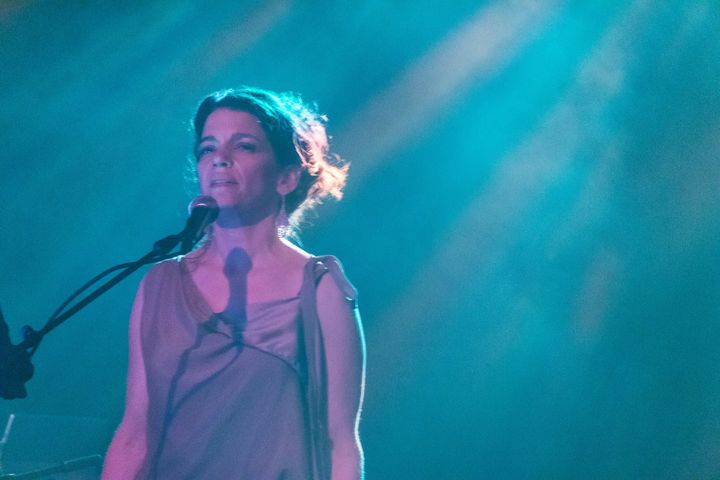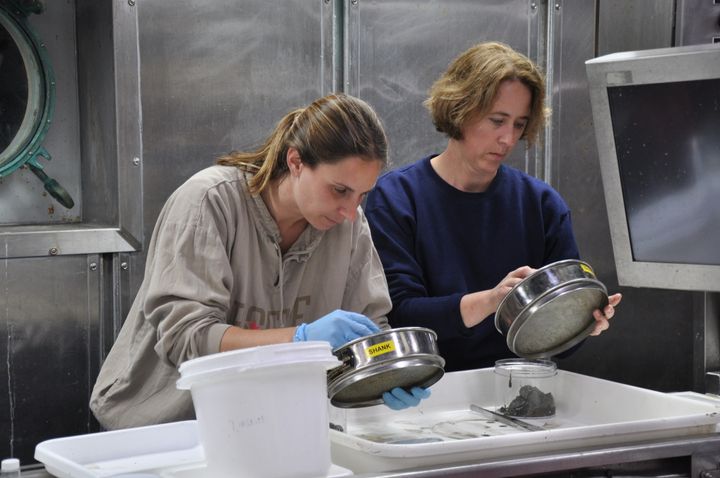
Carla Kihlstedt, lead singer, songwriter and violinist, performs on April 21. Her upbringing in Woods Hole, Massachusetts inspired a lifelong love of the ocean, which she chronicled in this project.
On August 2, 2015, Natalia Molchanova disappeared during an unplanned and unmonitored dive off the coast of Spain. Widely recognized as the world’s greatest free diver, she held 41 world records in the sport, including descending 71 meters underwater with no guiding rope or fins.
Molchanova, who was leading a recreational diving lesson at the time, took a single deep breath and descended 35 meters. She did not resurface, and her body was never found.
But what if her life didn’t end? What if Molchanova, always so drawn to the mysterious depths, just kept swimming?
This imaginative question became the inspiration for the new musical project, “Lost City: Songs from a Changing Sea,” launched by the Massachusetts-based husband-and-wife musical duo Carla Kihlstedt and Matthias Bossi— known to their fans as Rabbit Rabbit Radio—and their compatriot Jeremy Flower.
Four years ago, Kihlstedt and Bossi launched a creative subscription model for Rabbit Rabbit Radio ahead of the collapsing music industry. For a few dollars each month, subscribers can access the band’s archives, and hear a brand new song every four weeks. Though socially-conscious art is a new venture for the couple, their band is by no means typical of today’s music scene.
“Songs from a Changing Sea,” an 11-song composition, debuted live through USC’s Visions and Voices initiative this Spring. It explores the connection between humans and the ocean, challenging listeners to forge a spiritual bond, rather than a merely practical one, with the sea.
“The fact that [Molchanova] disappeared felt to me like an invitation,” said Kihlstedt, lead singer and violinist on the project. “Let’s just ignore the fact that of course it meant she died. Let’s take this as our point of departure, and imagine that she just kept going.”
The song cycle follows the journey of a diver as she explores, learns about and eventually becomes part of the sea. Along the way, she sees trash and pollutants discarded by humans who have little concern for the health of ocean ecosystems. And she struggles to sever her worldly ties, including to her own ego. Its creators ultimately plan to expand the show into a multimedia experience with a semi-permanent residency in New York to reach a larger audience.
At the show’s debut, Kihlstedt was bathed in eerie blue light and synthetic sea sounds as she sawed on her violin. She crooned, chanted, whispered, screeched. She was the mythical diver on an underwater journey, flanked by sirens: Kristin Slipp and Ariel Parkington, who also respectively played keyboards and violin.
The three were joined by four other musicians: Kihlstedt’s husband Matthias Bossi on the drums, USC Viterbi’s George Ban-Weiss on bass, guitarist Mike Abraham and electronic artist and composer Jeremy Flower.
The project is a foray into a world that blurs the boundaries between science and art, practical and spiritual—a world where conservation and ecology cannot be distilled into PowerPoint slides.
“Solving the ecological crisis is not something that can be done with logic alone,” said Dennis O’Hara, who directs the Elliot Allen Institute for Theology and Ecology in Toronto. “You need to include the irrational, the mythical, the mysterious.”
He says art has the capacity to reach people on this deeper, more primal level—which is exactly what Kihlstedt and her bandmates hope to do.
I lost my body in the waves
A vacuum, quiet…
The blue, blue abyss
From “The Blue Abyss” by Carla Kihlstedt, Matthias Bossi and Jeremy Flower
The show’s opening lines, adapted from Molchanova’s Russian poetry, capture the diver’s first moments beneath the surface. As she continues her descent, her ego starts to dissolve.
“She begins to lose her corporeal body and persona, and finds a bigger sense of self as part of this beautiful underwater world and part of ecology,” said Kilhstedt.

"Lost City: Songs from a Changing Sea" debuted live at USC on April 21st. The series of 11 songs explores a human spiritual connection to the ocean through the journey of a mythical free diver.
Discovering Molchanova’s poetry was an “aha moment” for Kihlstedt during the research phase. She was seeking a way to turn her idea into a powerful story, and admits that the task of writing a song cycle about the ocean felt “laughably vast” at first.
But O’Hara, the ecology expert, says ambition is necessary when tackling a problem of such magnitude.
“If you’re going to deal with the ecological crisis, which is an enormous crisis, you have to reinvent the human on a global scale. You have to tap into something larger than us—the story, not of the human, but of the universe,” he said. “You have to be not just bold, but ridiculously bold.”
O’Hara is referring to the eco-spirituality movement, which expands the traditionally human-centric idea of spiritual fulfillment to encompass all of ecology and creation. Over the past few decades, eco-spirituality has become a tool for those committed to reinventing the role of humanity in the worsening environmental crisis.
The movement has attracted people of faith—Christians, Muslims, Jews, Hindus, Buddhists, Pagans and indigenous peoples—as well as nonreligious groups. It has inspired both academic research and experimental creations including films, art installations and even an environmental mock-trial hosted by Canadian broadcaster and green activist David Suzuki.
A key tenet of eco-spirituality is that humans are part of a larger ecological system. That differs from the traditional Biblical understanding that places man as the steward of creation.
“Genesis tells us that God drops the human onto a prepared stage; the human is separated from everything else. But we know from the science of evolution that we’re all part of a continuous story, integrated with all of creation,” O’Hara said.
Here is where you come together
This is where you fall apart
While we watch from the shore and wave
From “Saline Dreams” by Carla Kihlstedt, Matthias Bossi and Jeremy Flower
Tackling such a vast subject required the project’s writers to break down content into manageable narratives, some of them deeply personal. The lyrics above, from the closing song “Saline Dreams,” celebrate the life of the late Arnold Bossi, the father of Matthias Bossi, Kihlstedt’s husband, coauthor and drummer for the project.
“This song celebrates his imaginative life, defined in so many ways by his relationship to the sea,” the band wrote in the event program. “He was not a seaman, nor a fisherman, nor an oceanographer, but as long as the ocean was close, he felt at home.”
After living for years in the seaside town of Woods Hole, Massachusetts, Kihlstedt and Bossi have an intimate knowledge of how the ocean shapes and sustains human life. With lyrics about coral spawns, dislocated aquatic creatures and the water cycle, the project reads more like a love song to the changing sea than an environmental call to action.
O’Hara says this tack, dissimilar to traditional ecological messaging, can be powerful.
“A problem of this magnitude cannot be solved with reason or logic alone. You have to fall in love, you have to have an irrational passion,” he said. “When you are defending someone you love you will do anything—there’s no logic there. You will risk your life.”
This is the sort of passion that the musicians hope to awaken in their audience. George Ban-Weiss, the project’s bassist and a professor of civil and environmental engineering at USC’s Viterbi School, concedes that the show may by nature attract listeners who are predisposed to environmental sensitivity.
“But even people who care a lot about the environment often do not take concrete steps to live a more sustainable life,” he said. “What it comes down to is that it’s really hard to change human behavior.”

George Ban-Weiss is a professor of civil and environmental engineering at USC Viterbi by day, and a semi-professional bass player by night. Performing "Lost City" was the first time Ban-Weiss merged his two passions into a single project.
Ban-Weiss sees “Songs from a Changing Sea” as an attempt to reach people on a different level. The project is a sort of experiment for him too: it’s the first time he’s merged “day-job George,” who researches air pollution and climate change, with “musician George,” who books gigs and records rock albums in his spare time.
“I’ve always wanted to bring those two worlds together: the music side and the science side, but all my ideas seemed too cheesy,” said Ban-Weiss, who worried that any attempt to merge the two might come across as cloying. But after performing live with Kihlstedt and Bossi, he was inspired by their storytelling abilities, and ultimately suggested an unusual collaboration.
“’Is there a way that we could create a set of music that would explore our relationship with the environment?’ That’s really all I said, and Carla said it lit the candle,” Ban-Weiss explained.
These interdisciplinary alliances are key to moving the conversation forward, according to O’Hara, the eco-spirituality expert.
“It takes a chorus of voices,” he said. “We need scientists to tell us the extent of the problem, and to develop new technologies. But among those voices we absolutely and critically need the artists, the authors, the painters—the people who can stir our imagination and touch us on a deep, primal level.”
Unbind me
Break me down.
Colonize these bones.
Lipid, sugar, sulfide, carbon.
Now I feed the hunted
From “Whale Fall” by Carla Kihlstedt, Matthias Bossi and Jeremy Flower
The song entitled “Whale Fall” explores an ecological phenomenon of the same name. When a whale dies, its body sinks to the ocean floor. A parade of sea creatures arrives to feed off the carcass, creating from death a garden of life that thrives for years. The whale’s body sustains generations of organisms and creates a new ecosystem in the ocean’s depths.
To recreate scientific phenomena such as whale fall, Kihlstedt relied on the expertise of researchers at the Woods Hole Oceanographic Institute in her Massachusetts hometown. Taylor Heyl, a biologist at the institute and a close friend of Kihlstedt’s, served as a liaison between the band and the scientific community.
In addition to teaching Kihlstedt about whale fall, Heyl invited the songwriter to visit the lab for “telepresence cruises,” in which the researchers participated in deep sea dives via a live stream. Heyl also shared details of a personal research project: she was cataloging anthropogenic trash in submarine caves off the coast of Massachusetts. After analyzing 96,000 still images, she shared the trash list with Kihlstedt, who incorporated it into the song cycle.
Heyl and her colleagues frequently welcome artists—including writers, illustrators and musicians—to join their research cruises. They encourage the guests to translate what they learn about the ocean environment into novels, illustrations and songs for the general public.
“A science like this tends to be very dry, very regimented in some ways. It really is hard to communicate to the public what you’re doing and why it’s important,” Heyl said. “If people can see it through art, or feel it spiritually through music, it brings a whole new dimension that helps people connect.”

Heyl, left, identifies samples of marine life onboard Alvin, one of the Woods Hole Oceanographic Institute research ships.
As part of her role consulting for the project, Heyl also wrote a private account for Kihlstedt, chronicling what it feels like to descend the water column during a research dive. The two spent hours discussing the logistics of dives, including what lighting and equipment the scientists use, with the goal of recreating those moments through music.
“That was an amazing experience just to see; she captured it beautifully,” Heyl said of the finished song cycle. “It really felt like I was descending the water column when I was listening to her music.”
*
For Kihlstedt, working on this piece was at times therapeutic. The exploration she did was as much internal as it was a performance.
“When I was seeing a therapist last year in Boston, there was a moment where she looked at me and laughed,” Kihlstedt said. “She said, ‘you think this is about the ocean, but it’s really about you.’”
Kihlstedt and her fellow songwriters hope sharing their personal journeys will encourage others to begin their own. Moving forward, the project will acquire video elements and assume a new name, “Black Inscription,” a term that refers to the line of dark microplants wherever the ocean meets rock—a universal boundary between water and land. Kihlstedt drew inspiration for the title from a nonfiction series about the ocean written by Rachel Carson, who also penned “Silent Spring,” a revolutionary book in the modern environmental movement.
“[The new title] sounded more like a personal thing, an inscription that we have to decipher,” Kihlstedt explained. “It asks more of the listener.”
O’Hara says unusual sounds and phrases that stir listeners, especially something dark such as “Black Inscription,” demonstrate the promise art holds for enacting change by pushing people out of their comfort zones.
“Radical change won’t come through comfort—we have to get uncomfortable,” he said. “And art is really good at making people uncomfortable.”
